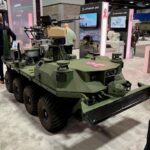
The global market for systems to defend against unmanned aircraft is growing rapidly as top Pentagon officials and members of Congress continue to prioritize their development and deployment across military and critical infrastructure applications. An industry report released by the Center for the Study of the Drone at Bard College found there are 537 counter-unmanned aircraft system (UAS) products on the market sold by 277 firms and partnerships — up from 235 products from 155 manufacturers just two years ago.…

 By
By 











